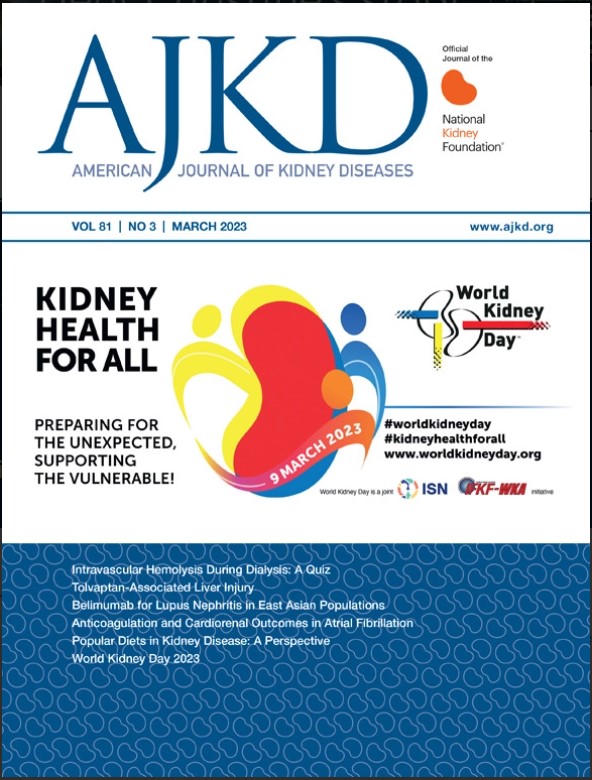Association of Coprescribing of Gabapentinoid and Other Psychoactive Medications With Altered Mental Status and Falls in Adults Receiving Dialysis
IF 8.2
1区 医学
Q1 UROLOGY & NEPHROLOGY
引用次数: 0
Abstract
Rationale & Objective
Prescribing psychoactive medications for patients with kidney disease is common, but for patients receiving dialysis some medications may be inappropriate. We evaluated the association of coprescribing gabapentinoids and other psychoactive potentially inappropriate medications (PPIMs) (eg, sedatives or opioids) with altered mental status (AMS) and falls and whether the associations are modified by frailty.
Study Design
Observational cohort study.
Setting & Participants
Adults receiving dialysis represented in the US Renal Data System who had an active gabapentinoid prescription and no other PPIM prescriptions in the prior 6 months.
Exposure
PPIM coprescribing, or the presence of overlapping prescriptions of a gabapentinoid and ≥1 additional PPIM.
Outcome
Acute care visits for AMS and injurious falls.
Analytical Approach
Prentice-Williams-Petersen Gap Time models estimated the association between PPIM coprescribing and each outcome, adjusting for demographics, comorbidities, and frailty, as assessed by a validated frailty index (FI). Each model tested for interaction between PPIM coprescribing and frailty.
Results
Overall, PPIM coprescribing was associated with increased hazard of AMS (HR, 1.66 [95% CI, 1.44-1.92]) and falls (HR, 1.55 [95% CI, 1.36-1.77]). Frailty significantly modified the effect of PPIM coprescribing on the hazard of AMS (interaction P = 0.01) but not falls. Among individuals with low frailty (FI = 0.15), the HR for AMS with PPIM coprescribing was 2.14 (95% CI, 1.69-2.71); for individuals with severe frailty (FI = 0.34), the hazard ratio for AMS with PPIM coprescribing was 1.64 (95% CI, 1.42-1.89). Individuals with PPIM coprescribing and severe frailty (FI = 0.34) had the highest hazard of AMS (HR, 3.22 [95% CI, 2.55-4.06]) and falls (HR, 2.77 [95% CI, 2.27-3.38]) compared with nonfrail individuals without PPIM coprescribing.
Limitations
Outcome ascertainment bias; residual confounding.
Conclusions
Compared with gabapentinoid prescriptions alone, PPIM coprescribing was associated with an increased risk of AMS and falls. Clinicians should consider these risks when coprescribing PPIMs to patients receiving dialysis.
Plain-Language Summary
Among people on dialysis, gabapentinoids may lead to confusion and falls. Often they are prescribed with other sedatives drugs or opioids, which can increase these risks. This study of adults with kidney failure receiving maintenance dialysis in the United States found that those who were prescribed both gabapentinoids and other psychoactive drugs were more likely to have confusion and falls compared with those who only took gabapentinoids. These relationships were seen at all levels of frailty although the relative risk of confusion related to an additional psychoactive drug was somewhat lower in the setting of greater frailty. Clinicians should consider elevated risks of confusion and falls when prescribing psychoactive drugs to patients receiving dialysis who are also prescribed gabapentinoids.

接受透析治疗的成人同时服用加巴喷丁类药物和其他精神活性药物与精神状态改变和跌倒的关系。
理由和目标:为肾病患者开具精神活性药物很常见,但对于接受透析的患者来说,有些药物可能并不合适。我们评估了合用加巴喷丁类药物和其他可能不适当的精神活性药物(PPIMs)(如镇静剂、阿片类药物)与精神状态改变(AMS)和跌倒的关系,以及这种关系是否会因体弱而改变:观察性队列研究:在美国肾脏数据系统中接受透析治疗的成年人,他们在过去 6 个月中拥有有效的加巴喷丁胺处方,且没有其他 PPIM 处方:PPIM联合处方,或存在一种加巴喷丁类药物和≥1种额外PPIM的重叠处方:分析方法:Prentice-Williams-Petersen间隙时间模型估计了PPIM联合处方与每种结果之间的关联,并对人口统计学、合并症和虚弱程度(通过有效的虚弱指数(FI)评估)进行了调整。每个模型都测试了 PPIM 联合处方与虚弱之间的交互作用:总体而言,PPIM联合处方与急性心肌梗死(HR:1.66 [95% CI 1.44, 1.92])和跌倒(HR:1.55 [95% CI 1.36, 1.77])风险增加有关。虚弱程度会明显改善 PPIM 联合处方对急性心肌梗死风险的影响(交互作用 p=0.01),但不会影响跌倒风险。在低度虚弱者(FI=0.15)中,PPIM 联合处方的急性呼吸系统综合症危险比为 2.14(95% CI:1.69, 2.71);而在重度虚弱者(FI=0.34)中,PPIM 联合处方的急性呼吸系统综合症危险比为 1.64(95% CI:1.42, 1.89)。与无PPIM联合处方的非虚弱人群相比,有PPIM联合处方且严重虚弱(FI=0.34)的人群发生AMS[HR 4.04 (95% CI: 3.20, 5.10)]和跌倒[HR 2.77 (95% CI: 2.27, 3.38)]的风险最高:局限性:结果确定偏差;残余混杂因素:与单独开加巴喷丁类药物处方相比,联合使用 PPIM 会增加急性心肌梗死和跌倒的风险。临床医生在为透析患者联合处方 PPIMs 时应考虑到这些风险。
本文章由计算机程序翻译,如有差异,请以英文原文为准。
求助全文
约1分钟内获得全文
求助全文
来源期刊

American Journal of Kidney Diseases
医学-泌尿学与肾脏学
CiteScore
20.40
自引率
2.30%
发文量
732
审稿时长
3-8 weeks
期刊介绍:
The American Journal of Kidney Diseases (AJKD), the National Kidney Foundation's official journal, is globally recognized for its leadership in clinical nephrology content. Monthly, AJKD publishes original investigations on kidney diseases, hypertension, dialysis therapies, and kidney transplantation. Rigorous peer-review, statistical scrutiny, and a structured format characterize the publication process. Each issue includes case reports unveiling new diseases and potential therapeutic strategies.
 求助内容:
求助内容: 应助结果提醒方式:
应助结果提醒方式:


